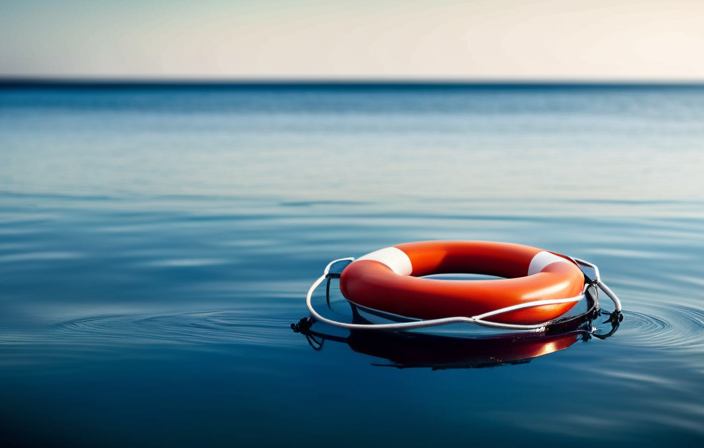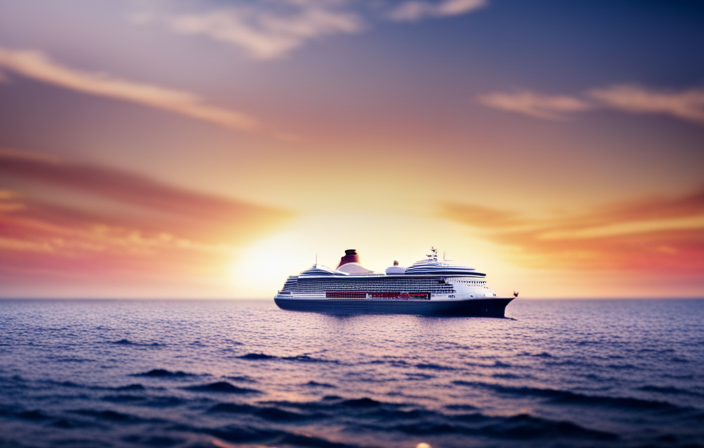The saying ‘Easy sailing isn’t guaranteed’ remains accurate, particularly when it comes to cruise ships. A concerning and often neglected fact is the occurrence of people going missing.
In this article, I will delve into the frequency of missing persons on cruise ships, provide statistics on these cases, and explore the challenges faced in investigating and locating individuals at sea.
Join me as we uncover the factors behind these disappearances and the impact it has on families. Let’s debunk myths and work towards improving safety protocols to reduce missing persons cases on cruise ships.
Key Takeaways
- Technological advancements have improved tracking of missing passengers on cruise ships through the use of advanced surveillance systems, GPS tracking devices, and facial recognition technology.
- International cooperation plays a crucial role in investigating missing persons cases on cruise ships, with the ship’s crew and security personnel working with local authorities and Interpol to gather information and coordinate efforts.
- Accidents or falls overboard, often caused by factors such as slippery decks, inadequate safety measures, and intoxication, are common reasons for disappearances from cruise ships.
- Cruise ships have implemented safety measures such as installing higher handrails and guardrails on decks, implementing stricter surveillance and monitoring systems, providing comprehensive safety training to crew members, and enforcing alcohol consumption limits to prevent missing passengers incidents.
The Frequency of Missing Persons on Cruise Ships
You might be wondering how often people actually go missing from cruise ships. Fortunately, technological advancements have greatly improved the tracking of missing passengers. Cruise ships are now equipped with advanced surveillance systems, GPS tracking devices, and even facial recognition technology to monitor the whereabouts of passengers at all times.
In addition, international cooperation plays a crucial role in investigating missing persons cases. When a person goes missing on a cruise ship, the ship’s crew and security personnel work closely with local authorities and Interpol to gather information, conduct searches, and coordinate efforts to locate the missing individual.
These advancements in tracking technology and international cooperation have significantly increased the chances of finding missing persons on cruise ships.
Now, let’s delve into the statistics on missing passengers from cruise ships.
Statistics on Missing Passengers From Cruise Ships
When discussing the statistics on missing passengers from cruise ships, it is important to address several key points.
Firstly, the reliability of missing passenger data is a crucial aspect to consider. It is essential to analyze how accurately and comprehensively cruise ships report these incidents.
Secondly, understanding the common reasons for disappearances can provide valuable insights into the risks involved and potential preventive measures.
Lastly, exploring cruise ship safety measures can shed light on the industry’s efforts to ensure the well-being of passengers and minimize the occurrence of such incidents.
These aspects collectively contribute to a comprehensive understanding of the statistics surrounding missing passengers on cruise ships.
Reliable Missing Passenger Data?
There’s no reliable data on missing passengers from cruise ships. The reliability of cruise ship surveillance and tracking missing passengers is a complex issue.
While cruise ships have various security measures in place, such as CCTV cameras and personnel, these systems are primarily focused on onboard safety and crime prevention. However, when it comes to tracking missing passengers, the data can be lacking.
There have been instances where passengers have gone missing, but due to the vastness of the ocean and the limited resources available, it can be challenging to accurately track and document such cases. In many instances, cruise ships rely on eyewitness accounts and testimonies from fellow passengers and crew members.
This lack of reliable data makes it difficult to determine the exact number of missing passengers from cruise ships. However, despite this limitation, there are common reasons for disappearances that can shed light on this issue.
Common Reasons for Disappearances?
One of the common reasons for disappearances on cruise ships is the prevalence of accidents or falls overboard. These incidents can occur due to various factors, including slippery decks, inadequate safety measures, and even intoxication. Here are some common factors that contribute to these accidents:
- Lack of proper handrails or guardrails on the ship’s decks
- Insufficient surveillance or monitoring systems
- Inadequate safety training for crew members
- Failure to enforce alcohol consumption limits
- Delays in initiating search and rescue operations
To prevent such incidents, cruise ships have implemented several prevention measures. These include:
- Installing higher handrails and guardrails on the decks
- Implementing stricter surveillance and monitoring systems
- Providing comprehensive safety training to crew members
- Enforcing alcohol consumption limits and conducting regular checks
- Establishing efficient search and rescue protocols
By implementing these prevention measures, cruise ships aim to ensure the safety and well-being of their passengers.
Transitioning into the subsequent section about ‘cruise ship safety measures,’ it is important to understand the comprehensive approach taken by the industry to maintain the highest levels of safety for passengers and crew members.
Cruise Ship Safety Measures?
To ensure your safety onboard, cruise ship companies have implemented a range of safety measures. One important aspect of these measures is cruise ship surveillance. These ships are equipped with advanced surveillance systems that monitor various areas of the ship, including public spaces and corridors. This surveillance helps in detecting any suspicious activities or potential risks.
Additionally, cruise ship staff undergo extensive training on how to handle missing persons cases. They are trained to act swiftly and efficiently in such situations, following specific protocols and procedures. This training includes conducting thorough searches, coordinating with onboard security, and notifying the appropriate authorities.
By implementing these surveillance measures and providing comprehensive training to staff, cruise ship companies aim to ensure the safety and security of their passengers.
Moving forward, let’s explore how these companies investigate missing persons cases on cruise ships.
Investigating Missing Persons Cases on Cruise Ships
When it comes to unresolved cruise ship disappearances, there are several key points to consider.
Firstly, the sheer number of missing persons cases at sea poses significant investigative challenges. With limited resources, jurisdictional complexities, and the vastness of the ocean, finding answers can be incredibly difficult.
Secondly, the lack of surveillance footage and reliable witnesses on board further complicates these investigations, leaving authorities with little to work with.
Lastly, the international nature of cruise ships adds another layer of complexity, as coordinating efforts between different countries’ law enforcement agencies can be time-consuming and bureaucratic.
Unresolved Cruise Ship Disappearances
If you’re curious about the unresolved cruise ship disappearances, there have been numerous cases that continue to baffle investigators.
Despite advances in technology and increased security measures, some individuals simply vanish without a trace while on a cruise ship. These unresolved disappearances pose significant challenges to cruise ship investigations, as they require a thorough examination of the ship’s surveillance footage, interviews with crew members and passengers, and coordination with local authorities in various jurisdictions.
Additionally, the vastness of the ocean and the transient nature of cruise ship travel make it difficult to conduct comprehensive searches. Investigators often face limited resources, jurisdictional complexities, and the lack of a centralized database for missing persons at sea.
These unresolved cases serve as a reminder of the investigative challenges at sea, where the truth may remain elusive.
Investigative Challenges at Sea
Navigating the vastness of the ocean and the complexities of jurisdiction, investigators like myself face significant challenges when attempting to solve cases at sea. The investigative techniques used in these situations require meticulous attention to detail and the ability to adapt to the unique circumstances of each case.
From conducting thorough interviews with witnesses and crew members to analyzing surveillance footage and collecting forensic evidence, every step of the investigation is crucial.
In addition, search and rescue operations play a vital role in locating missing individuals and gathering important information. These operations involve deploying specialized teams and equipment to search the vast expanses of the ocean, often relying on advanced technology such as sonar and satellite imagery.
Understanding the challenges of finding missing individuals at sea requires a comprehensive approach that takes into account the intricacies of maritime investigations and the unpredictable nature of the ocean.
Understanding the Challenges of Finding Missing Individuals at Sea
To understand the challenges of finding missing individuals at sea, you’ll need to consider the vastness of the ocean and the limited resources available for search and rescue operations. Investigative techniques and international coordination play crucial roles in these efforts.
When a person goes missing at sea, investigators must gather as much information as possible to determine the most likely location and circumstances surrounding their disappearance. This involves analyzing surveillance footage, interviewing witnesses, and examining any available evidence. However, these techniques can be hindered by the vastness of the ocean and the lack of specific information about the individual’s whereabouts.
International coordination is also vital, as missing persons cases at sea often involve multiple countries and jurisdictions. Sharing information and resources across borders is crucial for a successful search and rescue operation.
Transitioning into the next section, various factors contribute to people going missing from cruise ships, including onboard accidents and intentional acts.
Factors Contributing to People Going Missing From Cruise Ships
Various factors can contribute to individuals disappearing from cruise ships, such as accidents or intentional acts. It is important to understand the common patterns that emerge when someone goes missing on a cruise ship.
One common pattern is that most cases involve passengers rather than crew members. Additionally, a significant number of disappearances occur when the ship is docked at a port. This suggests that individuals may choose to intentionally leave the ship at these locations.
When someone goes missing, cruise lines have specific search and rescue procedures in place. These procedures involve conducting a thorough search of the ship, reviewing CCTV footage, and alerting the relevant authorities.
Despite these efforts, some cases of missing persons on cruise ships remain unresolved.
Unresolved Cases of Missing Persons on Cruise Ships
After examining the factors that contribute to people going missing from cruise ships, it is important to delve into the unresolved cases of missing persons on these vessels.
Investigative techniques play a crucial role in trying to uncover the truth behind these disappearances. Law enforcement agencies work closely with cruise lines to conduct thorough investigations, including reviewing surveillance footage, interviewing witnesses, and analyzing onboard activities.
In addition to official investigations, missing persons support groups provide invaluable assistance to families and loved ones left behind. These groups offer emotional support, share resources, and raise awareness about the issue. By collaborating with authorities and utilizing various techniques, they strive to bring closure to these heart-wrenching cases.
Transitioning into the subsequent section about notable incidents of missing passengers from cruise ships, it is important to highlight some of the most significant cases that have garnered attention worldwide.
Notable Incidents of Missing Passengers From Cruise Ships
Some of the most significant cases of passengers disappearing from cruise ships have gained worldwide attention. These unexplained disappearances have sparked international efforts to coordinate search and rescue operations and investigate the circumstances surrounding these incidents. The table below highlights a few notable incidents that have occurred in recent years:
| Incident | Date | Cruise Ship | Location |
|---|---|---|---|
| Amy Lynn Bradley | March 24, 1998 | Rhapsody of the Seas | Curacao |
| Rebecca Coriam | March 22, 2011 | Disney Wonder | Mexican Coast |
| George Allen Smith IV | July 5, 2005 | Brilliance of the Seas | Mediterranean Sea |
These cases remain unresolved, leaving families and authorities searching for answers. Despite the coordination of international efforts, the reasons behind these disappearances remain a mystery. Transitioning into the next section, it is crucial to examine the role of cruise ship crew in handling missing persons cases.
The Role of Cruise Ship Crew in Handling Missing Persons Cases
When you’re on a cruise ship, it’s essential to understand the role of the crew in handling missing persons cases. The cruise ship crew plays a vital role in search and rescue efforts, ensuring the safety and well-being of all passengers. Here are three ways in which they contribute to improving communication protocols for handling missing persons cases:
-
Conducting thorough searches: The crew is trained to conduct comprehensive searches of the ship to locate missing passengers. They check all public areas, cabins, and even restricted spaces to ensure no stone is left unturned.
-
Coordinating with authorities: The crew works closely with local authorities and coast guard agencies to initiate search and rescue operations promptly. They provide essential information and assist in coordinating efforts to locate the missing person.
-
Utilizing onboard technology: Cruise ships are equipped with advanced surveillance systems and communication tools. The crew utilizes these technologies to track movements, review CCTV footage, and gather crucial information that can aid in the search and rescue process.
Passenger Safety Measures to Prevent Missing Persons Incidents
To ensure your safety and prevent incidents of missing persons, it’s crucial to familiarize yourself with the passenger safety measures implemented on board.
Cruise ships are equipped with advanced surveillance systems to monitor the ship and its surroundings. These surveillance systems include CCTV cameras strategically placed throughout the ship, ensuring constant monitoring of public areas.
Additionally, crew members are trained to respond promptly and effectively in emergency situations. Emergency response procedures are in place to handle various scenarios, including missing persons cases. These procedures involve conducting a thorough search of the ship, activating emergency alarms, and notifying the bridge and other relevant personnel.
By being aware of these safety measures and cooperating with the crew during emergencies, you can help maintain a secure environment on board.
Now let’s discuss the search and rescue efforts for missing individuals on cruise ships.
Search and Rescue Efforts for Missing Individuals on Cruise Ships
Cruise ship crews are extensively trained to promptly respond to emergency situations, ensuring a swift and effective search and rescue effort for missing individuals.
When someone goes missing on a cruise ship, a coordinated response is initiated to locate and recover the individual. Investigative techniques are employed to gather information and identify potential areas where the person may be.
International cooperation plays a crucial role in these efforts, as cruise ships often operate in multiple jurisdictions. By working together, authorities from different countries can share resources, exchange information, and coordinate search efforts. This collaboration enhances the chances of finding the missing person and ensures a comprehensive investigation.
In cases like these, legal implications and responsibilities come into play, as cruise lines must adhere to international maritime laws and regulations regarding missing persons at sea.
Legal Implications and Responsibilities in Missing Persons Cases at Sea
If someone disappears on a cruise ship, you should be aware of the legal implications and responsibilities that come into play in missing persons cases at sea. When a person goes missing on a cruise ship, it is crucial to initiate a prompt and thorough investigation.
Investigative techniques, such as reviewing surveillance footage, interviewing witnesses, and conducting searches of the ship and surrounding waters, are employed to gather information and evidence. However, conducting investigations at sea presents unique challenges. Jurisdictional issues, varying international laws, and the involvement of multiple countries can complicate the legal process.
Additionally, cruise ship companies have a responsibility to cooperate fully with authorities and provide assistance in the investigation. The legal challenges faced in missing persons cases at sea highlight the need for international cooperation and standardized protocols to ensure a comprehensive and effective response.
Understanding these complexities is essential in addressing the emotional impact on families of missing persons from cruise ships.
The Emotional Impact on Families of Missing Persons From Cruise Ships
Understanding the emotional impact on families of missing loved ones can help provide support and empathy during these difficult times. When a person goes missing from a cruise ship, it can have a profound effect on their family members. The uncertainty and lack of closure can lead to feelings of anxiety, grief, and helplessness.
Emotional support for families in these situations is crucial. Cruise lines and support organizations can play a vital role in providing resources and counseling services to help families cope with their emotional distress.
Additionally, the impact of missing persons incidents on the cruise ship industry should not be overlooked. These incidents can lead to negative publicity and affect public perception of cruise ship safety.
Transitioning into the next section, media coverage and public perception of missing persons on cruise ships shed light on the importance of accurate and responsible reporting.
Media Coverage and Public Perception of Missing Persons on Cruise Ships
As I delve into the subtopic of media influence on perception and missing persons awareness, I aim to examine how the portrayal of missing persons cases in the media can shape public perception and impact the level of awareness surrounding these cases.
It is important to analyze how the media’s portrayal of missing persons can influence the public’s understanding, beliefs, and attitudes towards these incidents.
Media Influence on Perception
You might not realize it, but the media has a significant impact on how you perceive the number of people who go missing from cruise ships. Media bias can play a role in shaping public panic and creating a distorted perception of the actual number of missing persons. The constant coverage of cruise ship disappearances can make it seem like a common occurrence, when in reality, it is relatively rare. To illustrate this point, let’s take a look at the following table:
| Year | Reported Missing Persons |
|---|---|
| 2015 | 15 |
| 2016 | 10 |
| 2017 | 12 |
| 2018 | 9 |
| 2019 | 13 |
As you can see, the numbers are relatively low, yet media coverage often portrays these incidents as more frequent and widespread than they actually are. This can lead to unnecessary fear and panic among the public. It is important to be critical of the information presented by the media and to seek out accurate and unbiased sources when forming our perceptions. In the next section, we will explore the importance of missing persons awareness.
Missing Persons Awareness
If you’re looking to increase your awareness about missing persons, there are several organizations and resources available to provide you with information and support.
When it comes to missing persons prevention, one organization that stands out is the National Center for Missing & Exploited Children (NCMEC). They work tirelessly to prevent child abduction and provide support to families of missing children.
Another resource is the Missing Persons Support Center, which offers a wide range of services to families of missing persons, including counseling, support groups, and assistance with search efforts.
These organizations play a crucial role in raising awareness and providing much-needed support to families affected by missing persons cases.
Transitioning to the next section, it’s important to debunk myths and misconceptions about missing persons from cruise ships.
Debunking Myths and Misconceptions About Missing Persons From Cruise Ships
There’s a lot of misinformation out there about people going missing from cruise ships, but let’s debunk some of those myths.
One common misconception is that cruise ships lack proper surveillance systems. However, this couldn’t be further from the truth. Cruise ships are equipped with advanced surveillance technology, including CCTV cameras, which are strategically placed throughout the ship to monitor the onboard activities. These cameras provide crucial evidence in investigating any incidents, including cases of missing persons.
Additionally, cruise ships have strict protocols in place for coordinating with local authorities when a passenger goes missing. They immediately notify the appropriate authorities and work closely with them to conduct thorough searches of the ship and surrounding areas. This collaboration ensures that every effort is made to locate the missing individual and resolve the situation promptly.
Improving Safety and Security Protocols to Reduce Missing Persons Cases on Cruise Ships
To enhance safety and security on cruise ships, surveillance systems are continuously being upgraded and advanced technology is being implemented. This includes improving surveillance systems and training crew members to better handle emergency situations.
-
Advanced surveillance systems: By utilizing state-of-the-art cameras and monitoring equipment, cruise ships can capture and record activities in real-time, enhancing the ability to identify and respond to potential threats.
-
Enhanced training for crew members: Crew members are trained to be vigilant and proactive in maintaining the safety and security of passengers. They receive specialized training in areas such as emergency response, crowd management, and conflict resolution, ensuring they are prepared to handle any situation that may arise.
-
Collaborative efforts: Cruise ship companies work closely with law enforcement agencies and security experts to develop comprehensive protocols and procedures. This collaborative approach ensures that the latest security measures are implemented and continuously updated to address emerging threats.
Frequently Asked Questions
How Many People Go Missing From Cruise Ships Each Year?
Each year, a significant number of people go missing from cruise ships. This raises concerns about cruise ship security measures and the potential legal implications. It is important to thoroughly investigate these cases and ensure passenger safety.
Are There Any Unresolved Cases of Missing Persons on Cruise Ships?
There have been unresolved cases of missing persons on cruise ships. Cruise ship companies have legal responsibilities to investigate and report such cases. It is important to address these issues and ensure passenger safety.
What Role Do Cruise Ship Crew Members Play in Handling Missing Persons Cases?
In handling missing persons cases, cruise ship crew members play a crucial role. They are responsible for maintaining security and implementing communication protocols. Their expertise and quick response are essential in ensuring the safety and well-being of passengers.
What Are Some Common Factors That Contribute to People Going Missing From Cruise Ships?
Factors that contribute to people going missing from cruise ships include alcohol consumption, accidents, suicides, and foul play. Prevention measures such as increased surveillance, safety drills, and crew training can help address these issues and ensure passenger safety.
How Do Search and Rescue Efforts for Missing Individuals on Cruise Ships Work?
Search and rescue efforts for missing individuals on cruise ships involve meticulous protocols and coordination with local authorities. It’s like a well-orchestrated dance, where every step is taken to ensure a swift and effective response.
Conclusion
In conclusion, the number of people who go missing from cruise ships is a concerning issue that needs to be addressed. The statistics reveal the frequency of missing passengers, and investigating these cases is crucial in order to understand the challenges faced when finding individuals at sea.
Factors contributing to these incidents must be examined, and improving safety and security protocols is essential to reduce such cases. It is important to debunk myths and misconceptions surrounding these incidents and provide support to the families affected.
Together, we can navigate through these troubling waters and ensure the safety of all cruise ship passengers.










